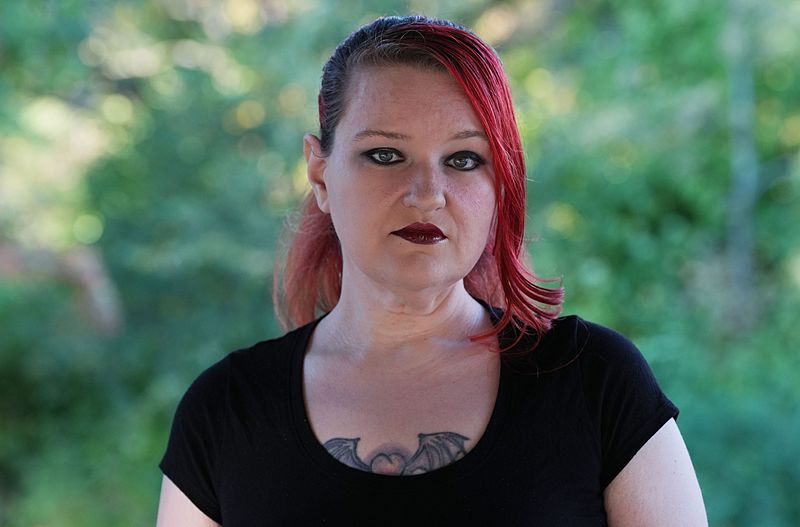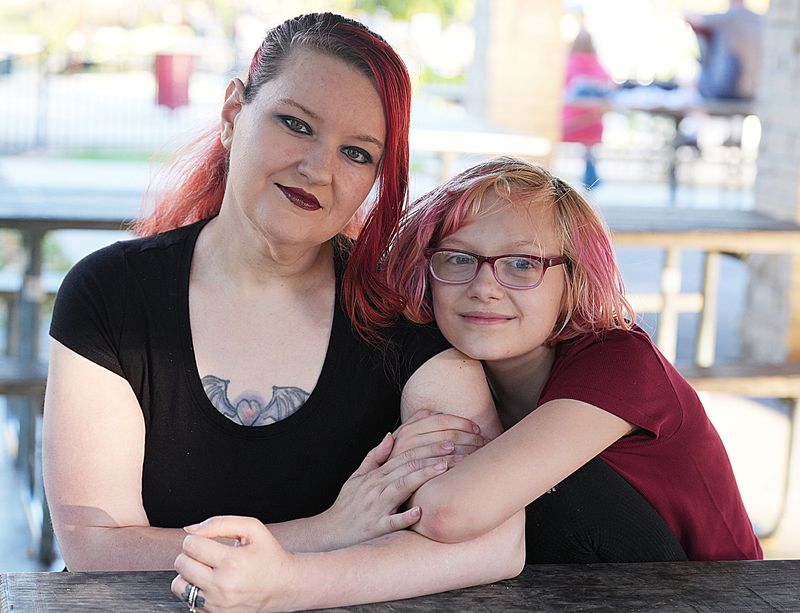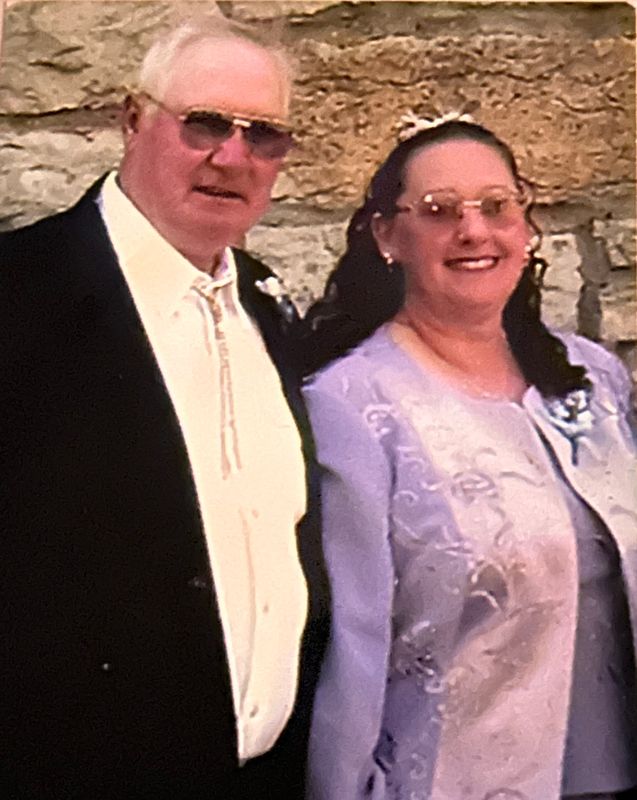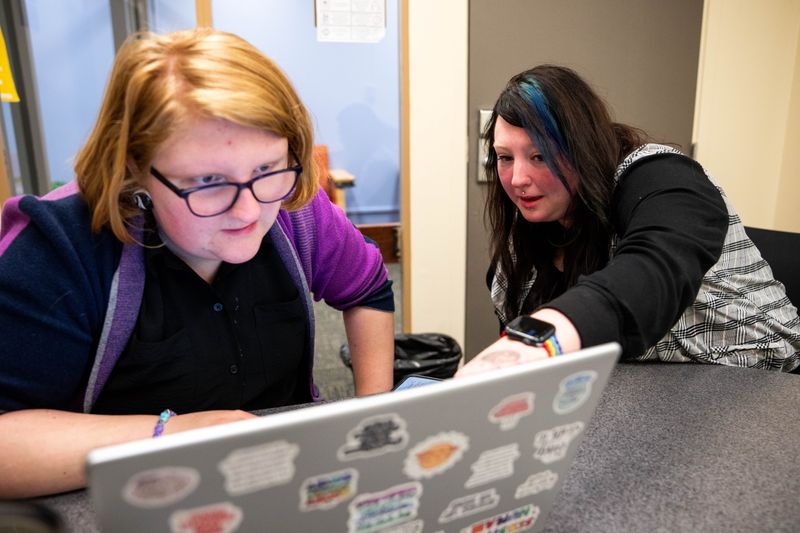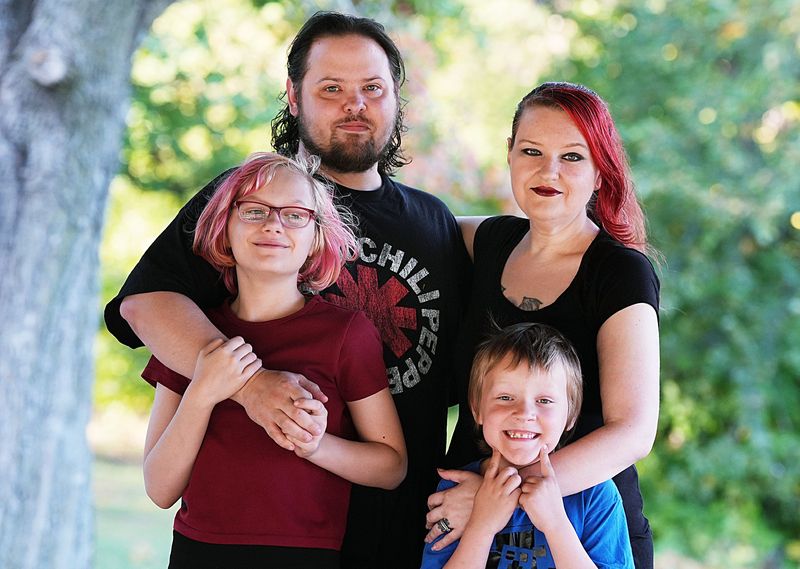Leigha Walker could’ve sketched where the paint was chipping in her elementary school’s hallways, the cracks and stains on its floor, with blueprint precision.
Teachers, she says, didn’t know what to do with a student like her. ADHD. Autism.

She moved up grades, changed classrooms, but their refrain stayed the same: You’re smart, but we can’t really support you. You can’t sit still. You can’t stop talking. You can’t. You can’t. You can’t.
“So, their solution? Put you in the hallway,” Walker said.
By middle school, she lost interest in learning.
And as a young adult, she failed out of Des Moines Area Community College twice. The hallway hadn’t prepared her to problem-solve all the challenges college presented: Balancing work and family and school, and navigating interpersonal relationships with professors and fellow students.
No, the hallway taught her to sit out the difficult stuff.
Then Walker became pregnant, a planned and wanted child, she stressed. But there’s nothing quite like impending motherhood to spark motivation, and, as she daydreamed about the full future she wished for her son, she knew she didn’t want him to accept failure as an endpoint.
Rather, she hoped he’d see missteps and mistakes as sometimes-necessary waystations toward success.
No hallways for him, she vowed.
So she retook all her classes. To muster focus, she treated each new course like a new stage in a video game: Pass this class, beat this level.
Another class, another level. Another and another. Until the last stage was won, that big boss finally beaten.
But when money got tight from a car crash that came days after putting a down payment on a house, education was hard to justify over food or gas or doctors’ appointments.
Walker was so close to her associate degree in early childhood education, with just lab classes left. She feared losing her grip on graduation for the third time — and that pit in her stomach was gnawing that if she did, she may never find her way back.
Have you heard about Embrace Iowa? Walker’s social worker asked at their next meeting. It’s a special fund, more open-ended than most, she said, and Walker could get up to $750 if she applied.
“It paid for one of my classes, another half of a class and textbooks. So that got me back into school,” said Walker, now 29, who was awarded $750 for tuition last year. “It was the push I needed.”
For more than 40 years, the Des Moines Register and its subscribers have partnered with the Iowa Community Action Association to endow Embrace Iowa, raising more than $5 million in the past two decades. Until the end of January, the Register is asking readers to donate, and will bring you the stories of those whom your dollars have directly helped — oftentimes right in a moment of crisis.
Embrace Iowa addresses an important and growing need in our state. It offers money that is flexible — one that doesn’t come with specific guidelines for what the money must be spent on or particular communities in which it must be used.
The only restraint on recipients is their annual income must be below 200% of the federal poverty level, which is about $64,000 for a family of four. All that freedom means the association can pivot quickly to help with immediate needs in Iowa’s 99 counties.
“We serve young families. We serve elderly individuals. We serve people with disabilities. We serve a lot of employed people, people who have jobs, but that job doesn’t provide enough income in order to meet their basic needs,” said Katherine Harrington, the association’s executive director.
Every year, the need way outpaces the donations, Harrington adds, and the need is growing still. Some of the association’s member agencies get 1,000 applications from families seeking relatively small amounts — $500 for furniture or $350 for a stove or $600 to cover rent so they can stay in their home while they figure out a long-term solution.
Or, as Walker likes to put it: $750 to help chart a new life. With the Embrace Iowa grant, and her own headstrong grit, she certainly did — and she’s not done yet.
Meeting Iowans in moments of extreme need: ‘We started over with nothing’
On the afternoon Cassie Lowe finally said out loud the words that had rattled around her head and heart for months — “I want a divorce” — her husband assaulted her. The terminus of abuse piled on top of neglect, the attack caused internal damage that would take weeks to reveal itself and years to heal.
When he was done, he threatened suicide, she said. All in front of her two kids.
Unbraiding their life together was made difficult by the realities of a decade of partnership: They shared bank accounts, a mortgage, car payments and two kids.
But just as hard was severing the emotional binds.
“I dealt with it because I grew up without a dad, and I didn’t want to do that to my children,” she said. “But when I saw that it was actually hurting them, that’s when I decided to make a plan to get out.”
She gave her ex most of their possessions, she said, and moved from eastern Iowa to Story County to be near her best friend.
“We started over here with nothing,” she said. “I didn’t have a trash can or dishes or silverware or a can opener, and that is not really something you think about until you don’t have it.”
“You get stuff from a pantry, like canned goods, but if you don’t have a can opener, you’re not going to get it open.”
She picked what bills to pay and what they could do without. They were one charge away from falling straight through their jerry-rigged financial underpinning.
Then that statement came: All four of her car’s tires weren’t holding air. They needed to be replaced. And Lowe wasn’t going to find $600 in her seat cushions.
More and more Iowans are one crisis away from being in poverty, according to research from the United Way that dovetails with anecdotal evidence from Harrington’s member agencies.
In Iowa, the number of households below the federal poverty level increased by 6 percentage points between 2010 and 2023, the research found. And the number of households where employed workers’ incomes totaled more than the poverty level but less than the basic cost of living grew by 27%.
“We are seeing a bigger and bigger gap between what people can bring in for income and what expenses are in order to just live a life,” Harrington said. “Basic needs are becoming more and more expensive, and incomes and salaries are not able to cover that.”
“So sometimes that $650 expense is the thing that forces you to make a decision between rent or utilities.”
In Lowe’s case, without reliable transportation, her kids wouldn’t make their therapy sessions. Miss enough and they’d be taken off the patient list.
Her daughter, Pandora, 12, vacillated from aggressive and angry to depressed and anxious. And her son, Damon, 6, was going through a violent period, which culminated in brutal night terrors.
Aftershocks, she believes, of what they witnessed when she was married.
She applied to Embrace Iowa and the $659 was paid directly to the mechanic for a new set of tires — a financial patch that allowed Lowe to get one step beyond crisis mode.
Even if full recovery still seems distant, meeting an emergent need feels like manifestation of a deeeppp breaathh for the families their agencies serve, Harrington said.
“It allows them to get out of lizard brain and reactivity and be able to make some solid plans in order to move forward,” she said.
And moving forward is most certainly the goal.
‘Situational changing’: Smaller amounts, flexible spending means more Iowans helped
When Gloria Robbins’ husband, Harry, discovered he had colon cancer, its course was terminal. Six months.
He went to specialist after specialist searching out a miracle, some kind of surgery to slow down cancer’s steady march, she said. But after a few weeks, his primary care doctor held his shoulders and told him that his body likely wouldn’t make it through a Hail Mary.
So Harry came home and spent the rest of his time embracing what gave him the most joy: putzing on his acreage, where he’d lived for more than 40 years, and around his small eastern Iowa community.
When Harry bought the property, the old house was unlivable, no running water or electricity. But he fixed it up. And over the years, the grounds became peppered with memories.
His children planted trees, including a white pine that’s 40-feet tall.
Family helped put together a 75-foot-long fence from antique hay loader and milk cart wheels. Gloria and Harry decorated it for holidays with so many lights that drivers could see them twinkling from up on the main road.
And the pair worked on an elaborate backyard garden that plays hosts to cardinals and goldfinches and woodpeckers. As he lost strength, Harry sat at the picture window and looked out over the blooms — the same place Gloria’s daughter sat as she, too, lost her own cancer battle.
Harry died six months almost to the day since his diagnosis, Gloria said. They’d been married more than 40 years, and, overnight, she lost half her income.
The bills piled. There were her husband’s hospital bills, his pharmacy bills, her insulin bills, not to mention utilities and food and gas.
She lived with her son for a time, so she could turn the heat down to 50 degrees in the house. But she still didn’t have the money for her mortgage, and she was in trouble of losing the acreage.
“I’ve got things around here that are soothing,” she said. And without them, she felt “pretty lost.”
In Iowa, consistent programs that supplement rent are difficult to access, and help with housing costs is one of the top requests for Embrace Iowa funds, Harrington said.
More than 60% of low-income renters in Iowa — including those who are over the federal poverty level but whose wages don’t cover basic costs of living — are “rent burdened,” meaning they are spending more than 30% of their income on housing, according to the United Way’s research. And that rate has held steady for the last few years.
“A lot of the programs that we run have stipulations on what we can and cannot spend money on, but this is a flexible pot of money,” Harrington said of Embrace Iowa. And this year, for the first time, Embrace Iowa funds will be available to use for food and holiday gifts, exclusions previously in place because other community resources filled these needs, but lifted due to the ongoing and widespread impacts of the government shutdown.
“So a lot of our dollars go to helping with that first or last month’s rent, or if somebody falls behind, helping to cover rent for a period of time until a family stabilizes.”
For Gloria, the $500 mortgage payment freed her to chip away at those other debts.
“It brought some happiness, if you will, to a bad situation,” she said.
The money Embrace Iowa gave — the most any recipient can receive is $750 — isn’t enough for a completely fresh start, but it is “situational changing,” Walker said.
“With a smaller amount, you have to almost get creative about how you tackle the problem,” she said.
“Now I have to have the motivation and the passion to figure out how to make it work.”
In a society that tends to demonize poverty, Embrace Iowa shares stories to humanize
Walker works as a tutor now — a cosmic reshifting of roles as she helps the students who, in some other universe, would be put in the hallway just as she was.
Her favorite class to teach is Fundamentals of Math, which is, as it sounds, very basic arithmetic. And so many of those sessions start the same way: With her students declaring they are, Just plain bad at math.
No, she says. It’s that no one has ever taken the time to sit down and explain it in a way that works with your brain.
“Growing up, I never had that,” she said. “Now I can be that person for other people.”
Lowe has gone back to college, starting by taking online classes at DMACC. She’s on track to graduate within a year.
And that best friend she moved to be near? They got married in a Beauty and the Beast-themed wedding because, as she said, he’s the reason she believes in fairy tales.
Robbins is still living on her property in eastern Iowa and still enjoys sitting by her picture window and looking out over the garden, which seemed to have extra big blooms this year.
Walker finally graduated from the DMACC Honors Program this spring. Last stage won. Big Boss beaten.
As she walked across the stage, she had the realization that her steps were built on a decade of failure. Failure before she found the support and services she needed. Failure before she became her own advocate.
She’s working on a bachelor’s through the University of Northern Iowa and would like to continue her education well past that degree — a doctorate is the goal.
And so is coming back to work at DMACC, where she’d like to be a bridge between faculty and community college students, especially ones with jobs and families and fears.
She’s been them, after all. She’s spent time in those hallways, literal and metaphorical.
She, too, has experienced failure. But not as an endpoint — just a waystation to success.
Courtney Crowder is the Register’s Iowa Columnist and a senior writer. Please share stories and tips at ccrowder@dmreg.com or 515-284-8360.
How to donate to Embrace Iowa
Embrace Iowa will take donations until the end of January 2026. Awards will be distributed directly to creditors through the fall or whenever the fund runs out. The Iowa Community Action Association does not use any of the Embrace Iowa monies for administrative fees.
Donate now by clicking here or visiting IowaCommunityAction.org.
This article originally appeared on Des Moines Register: More Iowans need assistance with basic needs. Embrace Iowa offers a way to help.
Reporting by Courtney Crowder, Des Moines Register / Des Moines Register
USA TODAY Network via Reuters Connect

